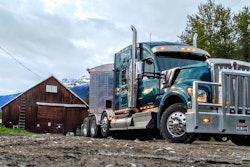
Class 8 truck orders continued trending down in February as trucking companies remain uncertain about how the economy will evolve in the months ahead, FTR and ACT Research reported Tuesday.
FTR reported February orders at 17,000 units, “well below seasonal expectations,” down 31% month over month and 38% from February 2024. ACT Research's total was slightly better at 18,300 units, but still down 34% year over year. FTR adds for the first time since the 2025 order season began, cumulative net orders from September 2024 through February 2025 are down year over year at 3%. The company also notes Class 8 orders have totaled 266,900 units over the last 12 months.
“After the strong end to 2024, the past two months have largely been defined by trade and economic policy uncertainty, as the new administration has thrown a wrench into business planning,” says Carter Vieth, research analyst at ACT Research. “Whether the slowdown in orders is a result of moderating economic activity or a response to the newfound uncertainty remains an open question.”
[RELATED: Economists at Work Truck Show struggle to make sense of Trump tariffs]
Digging deeper into the data, FTR reports OEMs across the board experienced a significant decline in order activity for February. The on-highway market accounted for the bulk of the monthly declines, although vocational orders were also down notably month over month.
“Significant U.S. tariffs could substantially increase costs for North American Class 8 trucks/tractors and related components. Approximately 45% of all Class 8 trucks built for the U.S. and Canadian markets will be subject to the 25% U.S. tariff on all imports from Canada and Mexico and planned Canadian counter tariffs. About 40% of U.S. Class 8 trucks are produced in Mexico, and roughly 65% of Canada’s Class 8 trucks are assembled in the U.S.,” says Dan Moyer, senior analyst, commercial vehicles.
“Even if those tariffs went away, others affecting costs include those on steel and aluminum, goods imported from China, and perhaps others coming down the pike.”

February's data isn't improved by seasonal adjustments either. Vieth says seasonally adjusted orders were 16,700 units, down 28% from January, “the lowest seasonally adjusted reading in almost two years.” FTR notes the month was well below the seven-year February average of 26,912 net orders.
“Combined with upcoming U.S. EPA 2027 NOx regulations, tariffs may significantly disrupt fleet replacement cycles — either accelerating investments to avoid future price hikes or delaying purchases amid growing uncertainty,” says Moyer. “Based on February orders, the latter approach apparently is the dominant path so far. OEMs and suppliers may consider shifting production to manage tariff exposure. However, these strategic changes remain costly, complex, and time-intensive, further complicating industry planning.”
In the medium-duty market, Vieth reports Class 5-7 orders “continued their slowly deflating trajectory into still historically elevated (if less so) truck and bus backlogs. ACT's preliminary look at February NA Class 5-7 orders puts the month's volume at 17,100 orders, down 11% year over year.”










